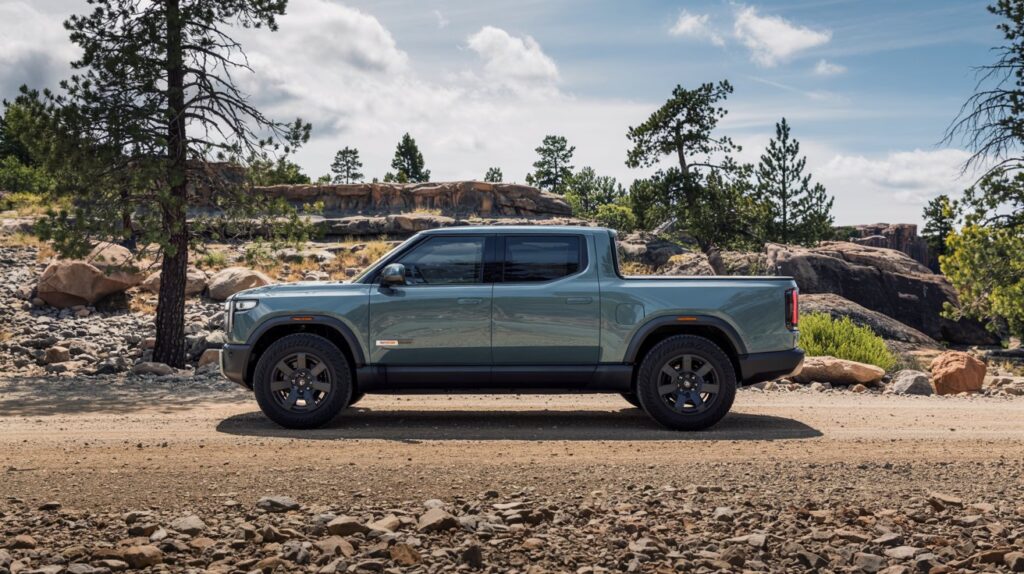Introduction
The electric vehicle (EV) market is buzzing with innovation, but high prices often keep everyday buyers out of the driver’s seat. Enter the Slate Truck, a game-changing electric pickup unveiled by Slate Auto in April 2025. Backed by Amazon founder Jeff Bezos, this truck promises to make EVs accessible with a starting price under $20,000 after federal incentives. Unlike its flashy competitors, the Slate Truck embraces simplicity, offering a “blank slate” design that buyers can customize to fit their needs. This article explores the Slate Truck’s specifications, design philosophy, target market, and how it compares to other electric pickups, all while being optimized for the keyword “slate truck” to ensure maximum visibility.


Overview of the Slate Truck
The Slate Truck is a two-door, battery-electric pickup truck set to begin production in 2026. Assembled in Indiana, USA, it reflects Slate Auto’s commitment to domestic manufacturing and cost efficiency. Its compact size—about two-thirds the length of a Chevy Silverado EV—makes it ideal for urban environments or smaller tasks.
Key Specifications
| Category | Details |
|---|---|
| Manufacturer | Slate Auto |
| Production Start | Expected 2026 |
| Assembly Location | Indiana, USA |
| Body Style | 2-door pickup truck (convertible to SUV) |
| Layout | Rear-motor, rear-wheel-drive |
| Battery Options | 52.7 kWh (150 miles range), 84.3 kWh (240 miles range) |
| Charging | AC: 11 kW, DC: 120 kW, NACS connector |
| Dimensions | Length: 4,435 mm, Width: 1,793 mm, Height: 1,760 mm |
| Curb Weight | 1,634 kg |
| Powertrain | Single motor: 201 hp, 195 lb-ft torque |
| Suspension | Front: MacPherson struts, Rear: deDion axle with coil springs |
| Price | Starting ~$25,000, under $20,000 with EV incentives |
The base “Blank Slate” model is intentionally minimal, lacking an infotainment system, speakers, or power windows. Its unpainted gray polypropylene exterior can be customized with vinyl wraps, and it includes a phone mount (with an optional tablet mount) for navigation and audio. This stripped-down approach keeps costs low while meeting 2027 safety standards, like automatic emergency braking.
Design Philosophy and Customization
Slate Auto’s mantra is affordability through simplicity. The Slate Truck’s design eliminates costly features like paint shops or complex variants, saving an estimated $350M–$500M at scale (WIRED). Instead of a central touchscreen, it offers phone or tablet mounts, encouraging buyers to use their devices for connectivity.
Customization Options
- Accessories: Over 100 options, including electric window kits, seat covers, wheel styles, and wraps.
- Conversion Kits: Transform the truck into a five-seat SUV with a ~$5,000 flat-pack kit, complete with airbags and a reusable tailgate.
- DIY Focus: Accessories support professional or do-it-yourself installation, appealing to hands-on buyers.
This “blank slate” concept empowers customers to build their ideal vehicle, much like customizing a smartphone with accessories. It’s a stark contrast to the rigid trim levels of most EVs, offering flexibility that’s both practical and budget-friendly.
Target Market and Positioning
The Slate Truck targets a demographic often ignored by EV makers: wage earners and small businesses. Priced at roughly half the cost of competitors, it appeals to those who want an electric pickup without the premium price tag. Younger buyers, who are more open to EVs and personalization, are a key focus, with surveys showing they’re eager to spend on accessories.
Key Audiences
- Retail Buyers: Individuals seeking affordable, customizable EVs for personal use.
- Corporate Fleets: Ideal for last-mile delivery or utility tasks, with potential Amazon adoption.
- DIY Enthusiasts: Those who enjoy personalizing vehicles with aftermarket parts.
By positioning itself as an “anti-Tesla”, the Slate Truck appeals to practical buyers who value function over flash. Its retro styling, reminiscent of 1980s trucks, resonates with traditional pickup fans skeptical of futuristic designs like the Tesla Cybertruck.
Comparison with Other Electric Pickup Trucks
The Slate Truck enters a competitive market but carves a unique niche. Here’s how it stacks up against key rivals:
| Feature | Slate Truck | Ford F-150 Lightning | Rivian R1T | Tesla Cybertruck |
|---|---|---|---|---|
| Starting Price | ~$50,000 | ~$70,000 | ~$60,990 | |
| Range | 150–240 miles | Up to 320 miles | Up to 400 miles | Up to 500 miles |
| Powertrain | Single motor, 201 hp | Dual motors, ~450 hp | Quad motors, ~800 hp | Up to 3 motors, ~800 hp |
| Customization | Extensive (100+ accessories) | Limited to trims | Limited to trims | Limited to colors |
| Target Market | Budget buyers, fleets | Work-focused buyers | Adventure enthusiasts | Tech-savvy buyers |
Key Differences
- Price: The Slate Truck’s low cost makes it accessible, unlike the premium-priced F-150 Lightning, R1T, or Cybertruck (Torque News).
- Design: Its traditional, no-frills aesthetic contrasts with the Cybertruck’s futuristic look, appealing to conservative buyers.
- Features: Competitors offer advanced tech and higher performance, but the Slate Truck prioritizes affordability and customization.
The Slate Truck doesn’t aim to outmuscle its rivals; instead, it offers a practical, budget-friendly alternative for those who don’t need luxury or extreme performance.
Manufacturing and Production
Slate Auto’s Indiana factory underscores its commitment to American manufacturing. By producing domestically, the company avoids import tariffs and taps into local incentives. Its production process is streamlined to cut costs:
- Single Model: One base configuration reduces complexity.
- Composite Materials: Polypropylene panels eliminate expensive metal stamping and painting.
- No Paint Shop: The unpainted exterior further lowers costs.
This efficiency allows Slate to offer the truck at a fraction of competitors’ prices, making it a viable option for mass adoption (NBC News).
Future Outlook
The Slate Truck’s launch marks a pivotal moment for affordable EVs. Set to hit the market in late 2026, it could redefine what buyers expect from electric pickups. Challenges like scaling production and ensuring accessory availability remain, but Slate Auto’s focus on simplicity and customer empowerment is promising. Future expansions may include new models or partnerships, especially with Amazon for fleet use. If successful, the Slate Truck could inspire other manufacturers to prioritize affordability, broadening EV access.
Conclusion
The Slate Truck is a bold step toward making electric vehicles affordable and customizable for the masses. With its sub-$20,000 price point, extensive accessory options, and practical design, it stands out in a market dominated by high-end pickups. By targeting wage earners, fleets, and DIY enthusiasts, Slate Auto is addressing a critical gap in the EV landscape. As production nears, the Slate Truck has the potential to become a cornerstone of accessible electric mobility, proving that innovation doesn’t need a luxury price tag.



